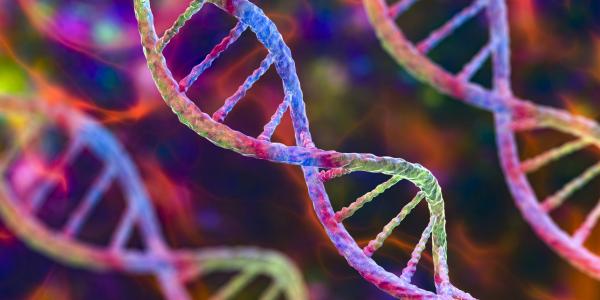New CU Boulder research shows that bacteria harness physical laws to operate at the edge of chaos and use calcium to independently diversify and find a place to settle down
Let’s talk about the bacteria in our colons.
Like all life on this planet, their main goal is to replicate their genome, passing it on to the next generation. But hostile environments like the colon force them to make tough choices: Hunker down here or swim farther downstream in hopes of greener pastures?
Meanwhile, all their kin are making the same calculation. Each has the same genome but can’t follow the same instruction manual or else they’ll all land on the same spot. They must diversify. So, how does a single-cell organism lacking the benefit of billions of neurons know how to do that?
Newly published research finds that bacteria—and not just the kinds in our colons, but many types in many environments—use changes in calcium, controlled through a process called “self-organized criticality,” to spontaneously diversify without the need for communication between cells. Bacteria use calcium not only in governing the transition to a biofilm, but in movement, maintaining cell structure and in infection.

Christian Meyer, a postdoctoral fellow in the University of Colorado Boulder Department of Molecular, Cellular and Developmental Biology, researched how bacteria use calcium to diversify.
Understanding how calcium is regulated in bacteria may have significant future implications for, among other applications, treating harmful biofilms that can form on surfaces. Further research may help scientists interrupt a bacterium’s calcium dynamics, perhaps preventing it from settling on a surface in the first place.
“Bacteria have so much to teach us,” says Christian Meyer, a postdoctoral fellow in the University of Colorado Boulder Department of Molecular, Cellular and Developmental Biology who completed the research with former CU Boulder assistant professor Joel Kralj. “There’s a fallacy in assuming that because something is small, it’s simple. Bacteria are using statistical mechanics to run computations instantaneously that I run over an entire weekend on my computer.”
Not more evolved than bacteria
In fact, Meyer’s research was inspired, in part, by the prevalent notion that humans are the pinnacle of evolution and the idea that “we’re more evolved than ________”—than amoebas, than earthworms, than bacteria.
“That’s not at all what evolutionary theory is saying,” Meyer notes. “The theory is that you, as a human, would make a horrible worm. Each unto their own niche. There are lots of systems in the natural world that operate without ‘intelligence,’ by which I mean that bacteria aren’t sitting there with a billion neurons at their disposal to figure out how much calcium they should let in right now. They have to do that rapidly and in changing environments, but also energy efficiently, and do it instantaneously—they’re not thinking.”
Originally, Meyer and his research colleagues studied antibiotics and how they modify the electrophysiology—or the electrical properties of cells that include current and voltage—of bacteria. They showed that E. coli bacteria, when treated with certain antibiotics, respond with changes in membrane potential.
In hundreds of videos of antibiotic-treated bacteria, the scientists watched calcium, as a marker of cell membrane voltage, going in and out of the cell. Instead of general randomness in that process, they saw power laws at work. Power laws describe the probability of an event happening as a function of its magnitude or duration. For example, the relationship between the probability and magnitude of an earthquake follows a power law, with large earthquakes being less likely than small ones.
Through further research with strains of E. coli, B. subtilis and P. putida bacteria, they found that calcium fluctuations resulted from a property known as self-organized criticality (SOC). SOC is a general property of many natural systems that are poised at the boundary between two phases without external control. Rather than separate states of matter, the phases are defined as different dynamical regimes, and often SOC systems are poised at the boundary between ordered and chaotic dynamics—what has been described as “order at the edge of chaos.”
Using self-organized criticality
Meyer and Kralj found that SOC can explain how bacteria cells exist on a knife’s edge between very high levels of calcium outside the cell and calcium levels that are about 100,000 times lower inside the cell. At high levels, calcium can be cytotoxic, meaning it can damage or kill cells. So, the bacteria‘s membranes operates somewhat like a dam, opening and closing rapidly and often—but not in a consistent pattern—to pump calcium in and out.

Bacteria expressing a fluorescent calcium sensor.
The research findings also suggest an evolutionary advantage of SOC, because it provides a way for individual bacteria to diversify, even without communicating with one another. SOC could be compared to a random number generator inside each bacteria cell, one that’s power law-based “so big events are more likely than they would be otherwise,” Meyer says.
“Because of this, going back to the example of bacteria in the colon, a bacterium will swim farther down the colon than it would if it was just randomly swimming. This is an extremely efficiently search strategy, to use power law-based searches in a domain. From my perspective, I think how incredible it is that they’re using a physical process to run computations to figure out what they should be doing, all without talking to each other or ‘thinking’.”
While understanding how calcium dynamics in bacteria result from SOC is an important step, further research will need to study how to target calcium while leaving a bacterium’s membrane electrical voltage intact. Then researchers can begin working toward applications like treating harmful biofilms.
“I’ve really grown to admire what bacteria are capable of doing,” Meyer says. “Imagine being a one-femtoliter cell (one-quadrillionth of a liter) and having to survive in the crazy world we live in with all the changes in temperature and pH and nutrients. It’s a hard world, but they’ve come up with incredibly elegant solutions to the complex challenges they face.
“In some ways, I’ve been inspired thinking how can we co-opt some of these natural processes for solving some of the issues humans face and do it in an intelligent way, things bacteria figured out a long time ago. SOC systems are an interesting mixture of flexible yet robust without the need for constant tuning. These seem desirable properties for many anthropogenic systems, from AI to social networks. I’ve come to appreciate bacteria as good examples of combating that fallacy of we are the pinnacle of evolution. They have amazing secrets to teach us, we just have to look at them.”
Top image: AI-generated picture of bacteria
Did you enjoy this article? Subcribe to our newsletter. Passionate about molecular biology? Show your support.



